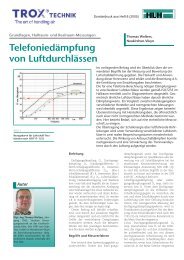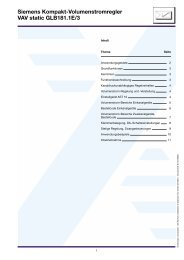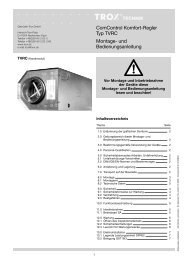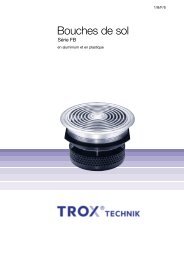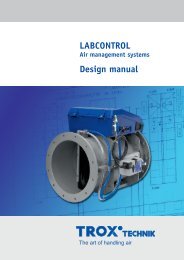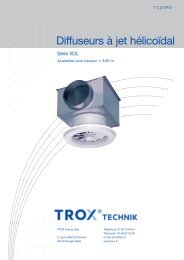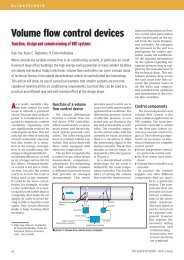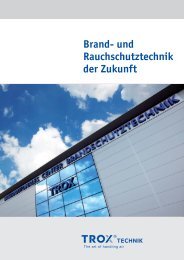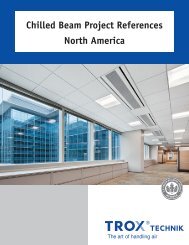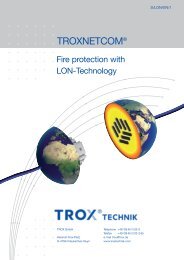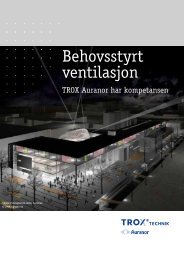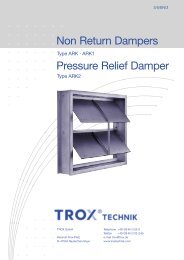ASHRAE Journal: Designing Chilled Beams for Thermal ... - TROX
ASHRAE Journal: Designing Chilled Beams for Thermal ... - TROX
ASHRAE Journal: Designing Chilled Beams for Thermal ... - TROX
You also want an ePaper? Increase the reach of your titles
YUMPU automatically turns print PDFs into web optimized ePapers that Google loves.
<strong>for</strong> a space whose latent gains total 400 Btu/h (117 W) can be<br />
calculated <strong>for</strong> various design humidity ratios:<br />
If W R OOM = 65 grains (50% RH) → Q PRIMARY = 84 cfm<br />
If W R OOM = 68 grains (52% RH) → Q PRIMARY = 59 cfm<br />
If W R OOM = 69 grains (53% RH) → Q PRIMARY = 53 cfm<br />
In this case, designing <strong>for</strong> 75°F (24°C) and 50% relative<br />
humidity would result in a primary airflow rate that is 58%<br />
higher than that required to maintain 53% RH in the space. As<br />
the 53% RH is within Standard 55-2004 recommendations and<br />
results in a space dew-point temperature of 57°F (14°C), it is<br />
probably a reasonable design goal.<br />
<strong>Chilled</strong> beams are often used with central HVAC equipment<br />
that includes heat recovery and enthalpy wheels. Lower space<br />
dew-point temperatures can be achieved when the dew-point<br />
temperature is further suppressed by these processes. In cases<br />
where room dew-point temperatures below 55°F (13°C) are<br />
desired, using such equipment is recommended.<br />
Summary<br />
Active chilled beams can be selected to remove large amounts<br />
of sensible heat while substantially reducing primary airflow<br />
requirements. However, this must be done with consideration<br />
Advertisement <strong>for</strong>merly in this space.<br />
of the occupant thermal com<strong>for</strong>t and space dehumidification.<br />
Because producing high levels of thermal com<strong>for</strong>t is the primary<br />
objective of any com<strong>for</strong>t cooling application, beams should be<br />
selected, sized and located with that in mind.<br />
While primary airflow reduction opportunities are an inherent<br />
characteristic of chilled beams, the reduction of such should<br />
be limited to that required to provide adequate space humidity<br />
control. All-air systems almost always deliver a sufficient<br />
amount of dry air to satisfy the space sensible load, there<strong>for</strong>e,<br />
engineers often do not consider space latent loads in their selection.<br />
Individual space latent loads should be considered when<br />
designing chilled beam systems.<br />
In conclusion, the following design guidelines should be observed<br />
when selecting, sizing and locating active chilled beams:<br />
• <strong>Chilled</strong> beams should not be used in low ceiling<br />
height applications where the distance between the<br />
ceiling and the top of the occupied zone is less than<br />
3 ft (0.9 m).<br />
• When applied in lobbies, atriums or other areas with<br />
high and/or uncontrollable infiltration rates, provide<br />
adequate condensation prevention strategies.<br />
• To maintain high levels of thermal com<strong>for</strong>t (velocities<br />
within the occupied zone no greater than 50 fpm<br />
or [0.25 m/s]), active chilled beams were mounted<br />
at least 3.5 ft (1.1 m) above the designated occupied<br />
zone should be sized and located such that their throw<br />
to a terminal velocity of 100 fpm (0.5 m/s) does not<br />
exceed half the distance between them and another<br />
beam with an opposing blow. Active beams mounted<br />
6 ft (2 m)or more above the designated occupied zone<br />
may be located such that their throw to a terminal<br />
velocity of 150 fpm (0.75 m/s) is as much as half the<br />
distance between the beam and an adjacent beam with<br />
an opposing discharge.<br />
• Smaller nozzles result in higher induction ratios and<br />
higher sensible cooling capacities per cfm (m 3 /h) of<br />
primary air. However, the use of smaller nozzles generally<br />
results in higher noise levels and inlet pressure<br />
requirements <strong>for</strong> a given primary airflow rate that<br />
increases the number of beams required.<br />
• <strong>Designing</strong> <strong>for</strong> space humidity levels lower than that<br />
actually required may result in significantly higher<br />
primary airflow rates.<br />
References<br />
1. ANSI/<strong>ASHRAE</strong> Standard 55-2004, <strong>Thermal</strong> Environmental<br />
Conditions <strong>for</strong> Human Occupancy.<br />
2. Standard 55-2004, p. 3.<br />
3. 2009 <strong>ASHRAE</strong> Handbook—Fundamentals, p. 20.13.<br />
4. Koestal, A. 1954. “Computing temperature and velocities in<br />
vertical jets of hot or cold air.” ASHVE Transactions 60:385.<br />
5. 2007 <strong>ASHRAE</strong> Handbook—HVAC Applications, p. 56.4.<br />
6. ANSI/<strong>ASHRAE</strong> Standard 62.1-2004, Ventilation <strong>for</strong> Acceptable<br />
Indoor Air Quality, Table 6-1.<br />
7. Standard 55-2004, p. 5.2.1.1.<br />
8. 2009 <strong>ASHRAE</strong> Handbook—Fundamentals, p. 9.12.<br />
6 4 A S H R A E J o u r n a l O c t o b e r 2 0 0 9




